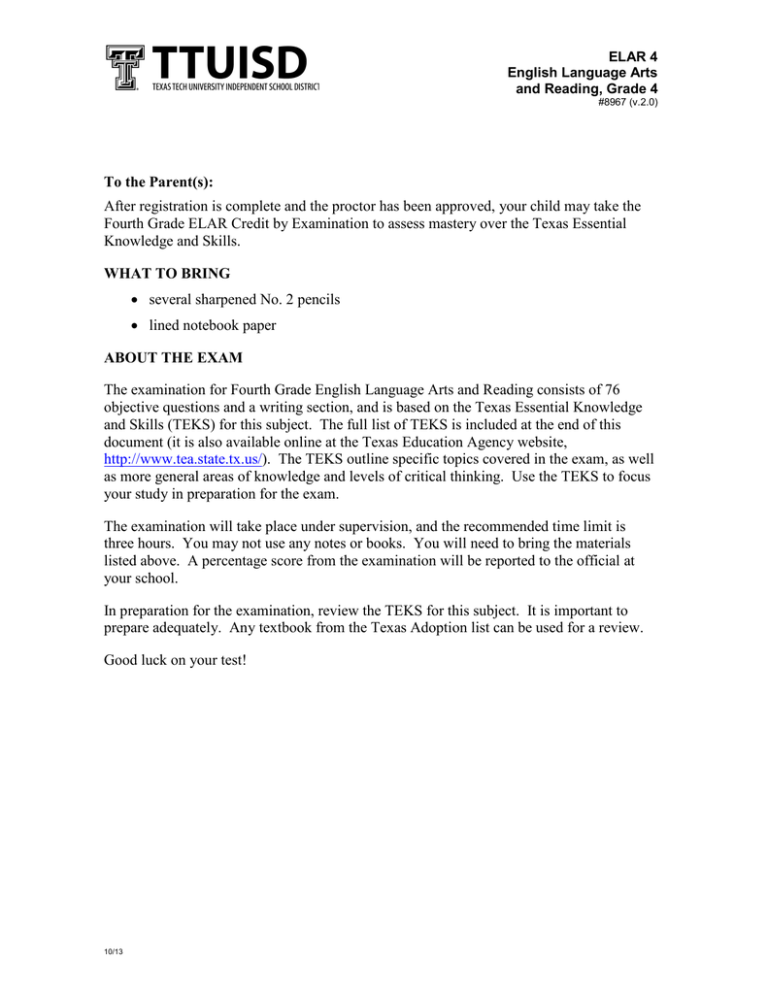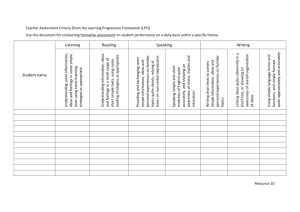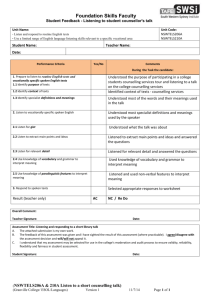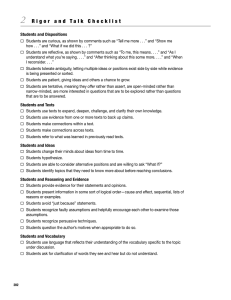After registration is complete and the proctor has been approved,... Fourth Grade ELAR Credit by Examination to assess mastery over... To the Parent(s):
advertisement

ELAR 4 English Language Arts and Reading, Grade 4 #8967 (v.2.0) To the Parent(s): After registration is complete and the proctor has been approved, your child may take the Fourth Grade ELAR Credit by Examination to assess mastery over the Texas Essential Knowledge and Skills. WHAT TO BRING • several sharpened No. 2 pencils • lined notebook paper ABOUT THE EXAM The examination for Fourth Grade English Language Arts and Reading consists of 76 objective questions and a writing section, and is based on the Texas Essential Knowledge and Skills (TEKS) for this subject. The full list of TEKS is included at the end of this document (it is also available online at the Texas Education Agency website, http://www.tea.state.tx.us/). The TEKS outline specific topics covered in the exam, as well as more general areas of knowledge and levels of critical thinking. Use the TEKS to focus your study in preparation for the exam. The examination will take place under supervision, and the recommended time limit is three hours. You may not use any notes or books. You will need to bring the materials listed above. A percentage score from the examination will be reported to the official at your school. In preparation for the examination, review the TEKS for this subject. It is important to prepare adequately. Any textbook from the Texas Adoption list can be used for a review. Good luck on your test! 10/13 Texas Essential Knowledge and Skills ELAR 4 – English Language Arts and Reading, Grade 4 §110.6. English Language Arts and Reading, Grade 4. (a) Introduction. (1) In Grade 4, students spend significant blocks of time engaged in reading and writing independently. Fourth grade students are critical listeners and analyze a speaker's intent such as to entertain or to persuade. When speaking, they adapt their language to the audience, purpose, and occasion. Students continue to read classic and contemporary selections. Fourth grade students read with a growing interest in a wide variety of topics and adjust their reading approach to various forms of texts. Students expand their vocabulary systematically across the curriculum. Students read for meaning and can paraphrase texts. Students are able to connect, compare, and contrast ideas. Fourth grade students can identify and follow varied text structures such as chronologies and cause and effect. Students produce summaries of texts and engage in more sophisticated analysis of characters, plots, and settings. Fourth grade students are able to select and use different forms of writing for specific purposes such as to inform, persuade, or entertain. Their writing takes on style and voice. Fourth grade students write in complete sentences. Students vary sentence structure and use adjectives, adverbs, prepositional phrases, and conjunctions. Fourth grade students are proficient spellers. Students edit their writing based on their knowledge of grammar and usage, spelling, punctuation, and other conventions of written language. Students can produce a final, polished copy of a written composition. Fourth grade students understand and use visual media and can compare and contrast visual media to print. (2) For fourth grade students whose first language is not English, the students' native language serves as a foundation for English language acquisition. (3) The essential knowledge and skills as well as the student expectations for Grade 4 are described in subsection (b) of this section. Following each statement of a student expectation is a parenthetical notation that indicates the additional grades at which these expectations are demonstrated at increasingly sophisticated levels. (4) To meet Public Education Goal 1 of the Texas Education Code, §4.002, which states, "The students in the public education system will demonstrate exemplary performance in the reading and writing of the English language," students will accomplish the essential knowledge and skills as well as the student expectations for Grade 4 as described in subsection (b) of this section. (5) To meet Texas Education Code, §28.002(h), which states, ". . . each school district shall foster the continuation of the tradition of teaching United States and Texas history and the free enterprise system in regular subject matter and in reading courses and in the adoption of textbooks," students will be provided oral and written narratives as well as other informational texts that can help them to become thoughtful, active citizens who appreciate the basic democratic values of our state and nation. (b) Knowledge and skills. (1) Listening/speaking/purposes. The student listens actively and purposefully in a variety of settings. The student is expected to: (A) determine the purposes for listening such as to gain information, to solve problems, or to enjoy and appreciate (4-8); (B) eliminate barriers to effective listening (4-8); and (C) understand the major ideas and supporting evidence in spoken messages (4-8). (2) Listening/speaking/critical listening. The student listens critically to analyze and evaluate a speaker's message(s). The student is expected to: (A) interpret speakers' messages (both verbal and nonverbal), purposes, and perspectives (4-8); (B) identify and analyze a speaker's persuasive techniques such as promises, dares, and flattery (4-5); (C) distinguish between the speaker's opinion and verifiable fact (4-8); and (D) monitor his/her own understanding of the spoken message and seek clarification as needed (4-8). (3) Listening/speaking/appreciation. The student listens, enjoys, and appreciates spoken language. The student is expected to: (A) listen to proficient, fluent models of oral reading, including selections from classic and contemporary works (4-8); (B) describe how the language of literature affects the listener (4-5); and (C) assess how language choice and delivery affect the tone of the message (4-5). (4) Listening/speaking/culture. The student listens and speaks both to gain and share knowledge of his/her own culture, the culture of others, and the common elements of cultures. The student is expected to: (A) connect his/her own experiences, information, insights, and ideas with those of others through speaking and listening (4-8); (B) compare oral traditions across regions and cultures (4-8); and (C) identify how language use such as labels and sayings reflects regions and cultures (4-8). (5) Listening/speaking/audiences. The student speaks clearly and appropriately to different audiences for different purposes and occasions. The student is expected to: 2 (A) adapt spoken language such as word choice, diction, and usage to the audience, purpose, and occasion (4-8); (B) demonstrate effective communications skills that reflect such demands as interviewing, reporting, requesting, and providing information (48); (C) present dramatic interpretations of experiences, stories, poems, or plays to communicate (4-8); (D) use effective rate, volume, pitch, and tone for the audience and setting (4-8); (E) give precise directions and instructions such as in games and tasks (4-5); and (F) clarify and support spoken ideas with evidence, elaborations, and examples (4-8). (6) Reading/word identification. The student uses a variety of word recognition strategies. The student is expected to: (A) apply knowledge of letter-sound correspondences, language structure, and context to recognize words (4-8); (B) use structural analysis to identify root words with prefixes such as dis-, non-, in-; and suffixes such as -ness, -tion, -able (4-6); and (C) locate the meanings, pronunciations, and derivations of unfamiliar words using dictionaries, glossaries, and other sources (4-8). (7) Reading/fluency. The student reads with fluency and understanding in texts at appropriate difficulty levels. The student is expected to: (A) read regularly in independent-level materials (texts in which no more than approximately 1 in 20 words is difficult for the reader) (4); (B) read regularly in instructional-level materials that are challenging but manageable (texts in which no more than approximately 1 in 10 words is difficult for the reader; a "typical" fourth grader reads approximately 90 wpm) (4); (C) demonstrate characteristics of fluent and effective reading (4-6); (D) adjust reading rate based on purposes for reading (4-8); (E) read aloud in selected texts in ways that both reflect understanding of the text and engage the listeners (4-8); and (F) read silently with increasing ease for longer periods (4-8). (8) Reading/variety of texts. The student reads widely for different purposes in varied sources. The student is expected to: (A) read classic and contemporary works (2-8); (B) select varied sources such as nonfiction, novels, textbooks, newspapers, and magazines when reading for information or pleasure (4-5); and (C) read for varied purposes such as to be informed, to be entertained, to appreciate the writer's craft, and to discover models for his/her own writing (4-8). (9) Reading/vocabulary development. The student acquires an extensive vocabulary through reading and systematic word study. The student is expected to: (A) develop vocabulary by listening to selections read aloud (4-8); (B) draw on experiences to bring meanings to words in context such as interpreting figurative language and multiple-meaning words (4-5); (C) use multiple reference aids, including a thesaurus, a synonym finder, a dictionary, and software, to clarify meanings and usage (4-8); (D) determine meanings of derivatives by applying knowledge of the meanings of root words such as like, pay, or happy and affixes such as dis-, pre-, un- (4-8); and (E) study word meanings systematically such as across curricular content areas and through current events (4-8). (10) Reading/comprehension. The student comprehends selections using a variety of strategies. The student is expected to: (A) use his/her own knowledge and experience to comprehend (4-8); (B) establish and adjust purposes for reading such as reading to find out, to understand, to interpret, to enjoy, and to solve problems (4-8); (C) monitor his/her own comprehension and make modifications when understanding breaks down such as by rereading a portion aloud, using reference aids, searching for clues, and asking questions (4-8); (D) describe mental images that text descriptions evoke (4-8); (E) use the text's structure or progression of ideas such as cause and effect or chronology to locate and recall information (4-8); (F) determine a text's main (or major) ideas and how those ideas are supported with details (4-8); (G) paraphrase and summarize text to recall, inform, and organize ideas (4-8); (H) draw inferences such as conclusions or generalizations and support them with text evidence and experience (4-8); (I) find similarities and differences across texts such as in treatment, scope, or organization (4-8); (J) distinguish fact and opinion in various texts (4-8); 3 (K) answer different types and levels of questions such as open-ended, literal, and interpretative as well as test-like questions such as multiple choice, true-false, and short answer (4-8); and (L) represent text information in different ways such as in outline, timeline, or graphic organizer (4-8). (11) Reading/literary response. The student expresses and supports responses to various types of texts. The student is expected to: (A) offer observations, make connections, react, speculate, interpret, and raise questions in response to texts (4-8); (B) interpret text ideas through such varied means as journal writing, discussion, enactment, media (4-8); (C) support responses by referring to relevant aspects of text and his/her own experiences (4-8); and (D) connect, compare, and contrast ideas, themes, and issues across text (4-8). (12) Reading/text structures/literary concepts. The student analyzes the characteristics of various types of texts (genres). The student is expected to: (A) judge the internal consistency or logic of stories and texts such as "Would this character do this?"; "Does this make sense here?" (4-5); (B) recognize that authors organize information in specific ways (4-5); (C) identify the purposes of different types of texts such as to inform, influence, express, or entertain (4-8); (D) recognize the distinguishing features of genres, including biography, historical fiction, informational texts, and poetry (4-8); (E) compare communication in different forms such as contrasting a dramatic performance with a print version of the same story or comparing story variants (2-8); (F) understand and identify literary terms such as title, author, illustrator, playwright, theater, stage, act, dialogue, and scene across a variety of literary forms (texts) (3-5); (G) understand literary forms by recognizing and distinguishing among such types of text as stories, poems, myths, fables, tall tales, limericks, plays, biographies, and autobiographies (3-7); (H) analyze characters, including their traits, motivations, conflicts, points of view, relationships, and changes they undergo (4-8); (I) recognize and analyze story plot, setting, and problem resolution (4-8); and (J) describe how the author's perspective or point of view affects the text (4-8). (13) Reading/inquiry/research. The student inquires and conducts research using a variety of sources. The student is expected to: (A) form and revise questions for investigations, including questions arising from interests and units of study (4-5); (B) use text organizers, including headings, graphic features, and tables of contents, to locate and organize information (4-8); (C) use multiple sources, including electronic texts, experts, and print resources, to locate information relevant to research questions (4-8); (D) interpret and use graphic sources of information such as maps, graphs, timelines, tables, and diagrams to address research questions (4-5); (E) summarize and organize information from multiple sources by taking notes, outlining ideas, or making charts (4-8); (F) produce research projects and reports in effective formats using visuals to support meaning, as appropriate (4-5); (G) draw conclusions from information gathered from multiple sources (4-8); and (H) use compiled information and knowledge to raise additional, unanswered questions (3-8). (14) Reading/culture. The student reads to increase knowledge of his/her own culture, the culture of others, and the common elements of cultures. The student is expected to: (A) compare text events with his/her own and other readers' experiences (4-8); (B) determine distinctive and common characteristics of cultures through wide reading (4-8); and (C) articulate and discuss themes and connections that cross cultures (4-8). (15) Writing/purposes. The student writes for a variety of audiences and purposes, and in a variety of forms. The student is expected to: (A) write to express, discover, record, develop, reflect on ideas, and to problem solve (4-8); (B) write to influence such as to persuade, argue, and request (4-8); (C) write to inform such as to explain, describe, report, and narrate (4-8); (D) write to entertain such as to compose humorous poems or short stories (4-8); (E) exhibit an identifiable voice in personal narratives and in stories (4-5); and (F) choose the appropriate form for his/her own purpose for writing, including journals, letters, reviews, poems, narratives, and instructions (45). 4 (16) Writing/penmanship/capitalization/punctuation. The student composes original texts, applying the conventions of written language such as capitalization, punctuation, and penmanship to communicate clearly. The student is expected to: (A) write legibly by selecting cursive or manuscript as appropriate (4-8); and (B) capitalize and punctuate correctly to clarify and enhance meaning such as capitalizing titles, using possessives, commas in a series, commas in direct address, and sentence punctuation (4-5). (17) Writing/spelling. The student spells proficiently. The student is expected to: (A) write with accurate spelling of syllable constructions, including closed, open, consonant before -le, and syllable boundary patterns (3-6); (B) write with accurate spelling of roots such as drink, speak, read, or happy, inflections such as those that change tense or number, suffixes such as -able or -less, and prefixes such as re- or un- (4-6); (C) use resources to find correct spellings (4-8); and (D) spell accurately in final drafts (4-8). (18) Writing/grammar/usage. The student applies standard grammar and usage to communicate clearly and effectively in writing. The student is expected to: (A) use regular and irregular plurals correctly (4-6); (B) write in complete sentences, varying the types such as compound and complex to match meanings and purposes (4-5); (C) employ standard English usage in writing for audiences, including subject-verb agreement, pronoun referents, and parts of speech (4-8); (D) use adjectives (comparative and superlative forms) and adverbs appropriately to make writing vivid or precise (4-8); (E) use prepositional phrases to elaborate written ideas (4-8); (F) use conjunctions to connect ideas meaningfully (4-5); (G) write with increasing accuracy when using apostrophes in contractions such as it's and possessives such as Jan's (4-8); and (H) write with increasing accuracy when using objective case pronouns such as "Dan cooked for you and me." (4-5). (19) Writing/writing processes. The student selects and uses writing processes for self-initiated and assigned writing. The student is expected to: (A) generate ideas and plans for writing by using such prewriting strategies as brainstorming, graphic organizers, notes, and logs (4-8); (B) develop drafts by categorizing ideas, organizing them into paragraphs, and blending paragraphs within larger units of text (4-8); (C) revise selected drafts by adding, elaborating, deleting, combining, and rearranging text (4-8); (D) revise drafts for coherence, progression, and logical support of ideas (4-8); (E) edit drafts for specific purposes such as to ensure standard usage, varied sentence structure, and appropriate word choice (4-8); (F) use available technology to support aspects of creating, revising, editing, and publishing texts (4-8); (G) refine selected pieces frequently to "publish" for general and specific audiences (4-8); (H) proofread his/her own writing and that of others (4-8); and (I) select and use reference materials and resources as needed for writing, revising, and editing final drafts (4-8). (20) Writing/evaluation. The student evaluates his/her own writing and the writings of others. The student is expected to: (A) apply criteria to evaluate writing (4-8); (B) respond in constructive ways to others' writings (4-8); (C) evaluate how well his/her own writing achieves its purposes (4-8); (D) analyze published examples as models for writing (4-8); and (E) review a collection of written works to determine its strengths and weaknesses and to set goals as a writer (4-8). (21) Writing/inquiry/research. The student uses writing as a tool for learning and research. The student is expected to: (A) frame questions to direct research (4-8); (B) organize prior knowledge about a topic in a variety of ways such as by producing a graphic organizer (4-8); (C) take notes from relevant and authoritative sources such as guest speakers, periodicals, and on-line searches (4-8); (D) summarize and organize ideas gained from multiple sources in useful ways such as outlines, conceptual maps, learning logs, and timelines (4-8); (E) present information in various forms using available technology (4-8); and 5 (F) evaluate his/her own research and raise new questions for further investigation (4-8). (22) Writing/connections. The student interacts with writers inside and outside the classroom in ways that reflect the practical uses of writing. The student is expected to: (A) collaborate with other writers to compose, organize, and revise various types of texts, including letters, news, records, and forms (4-8); and (B) correspond with peers or others via e-mail or conventional mail (4-8). (23) Viewing/representing/interpretation. The student understands and interprets visual images, messages, and meanings. The student is expected to: (A) describe how illustrators' choice of style, elements, and media help to represent or extend the text's meanings (4-8); (B) interpret important events and ideas gathered from maps, charts, graphics, video segments, or technology presentations (4-8); and (C) use media to compare ideas and points of view (4-8). (24) Viewing/representing/analysis. The student analyzes and critiques the significance of visual images, messages, and meanings. The student is expected to: (A) interpret and evaluate the various ways visual image makers such as graphic artists, illustrators, and news photographers represent meanings (4-5); and (B) compare and contrast print, visual, and electronic media such as film with written story (4-8). (25) Viewing/representing/production. The student produces visual images, messages, and meanings that communicate with others. The student is expected to: (A) select, organize, or produce visuals to complement and extend meanings (4-8); and (B) produce communications using technology or appropriate media such as developing a class newspaper, multimedia reports, or video reports (4-8). Source: The provisions of this §110.6 adopted to be effective September 1, 1998, 22 TexReg 7549. 6








